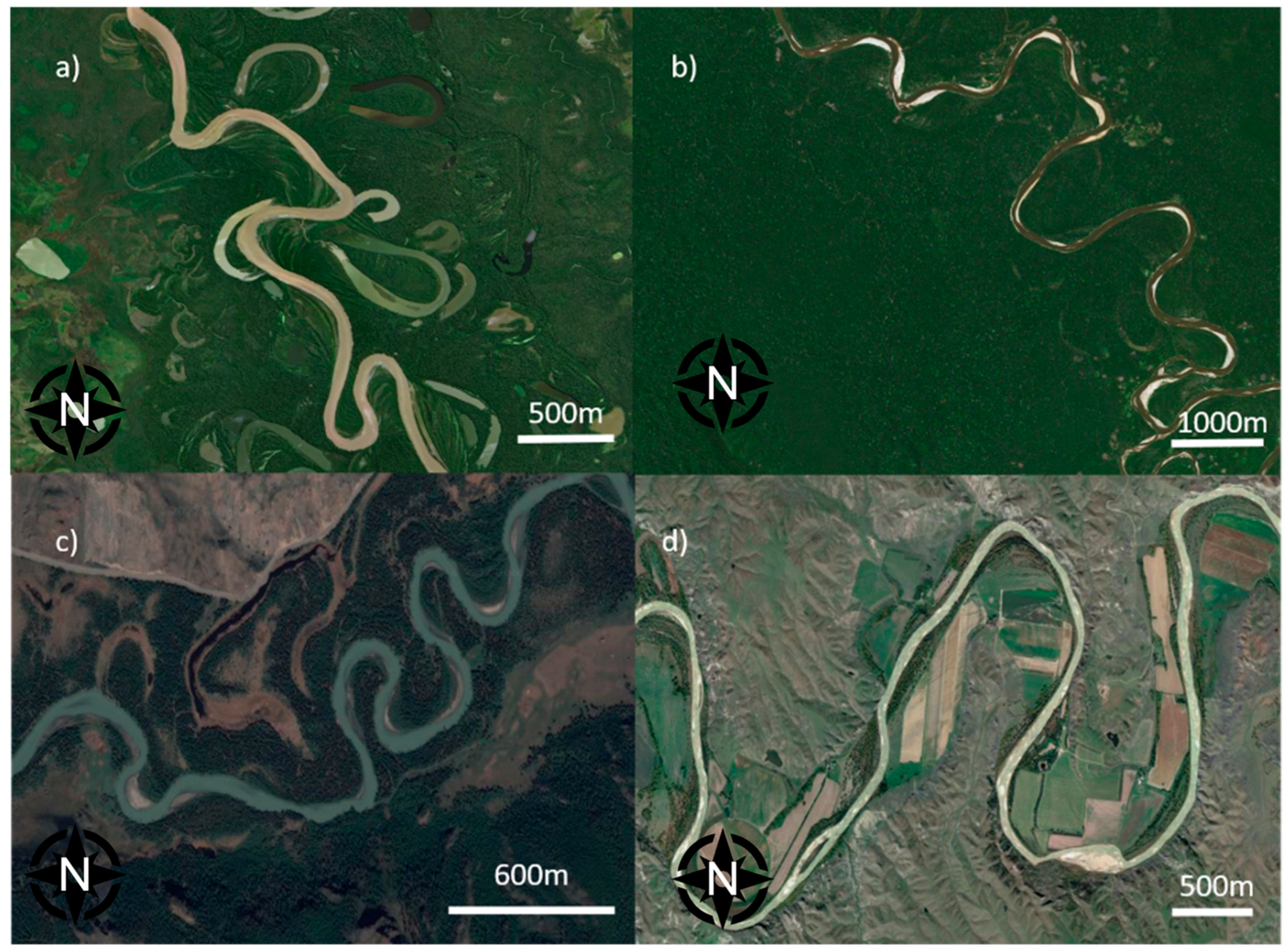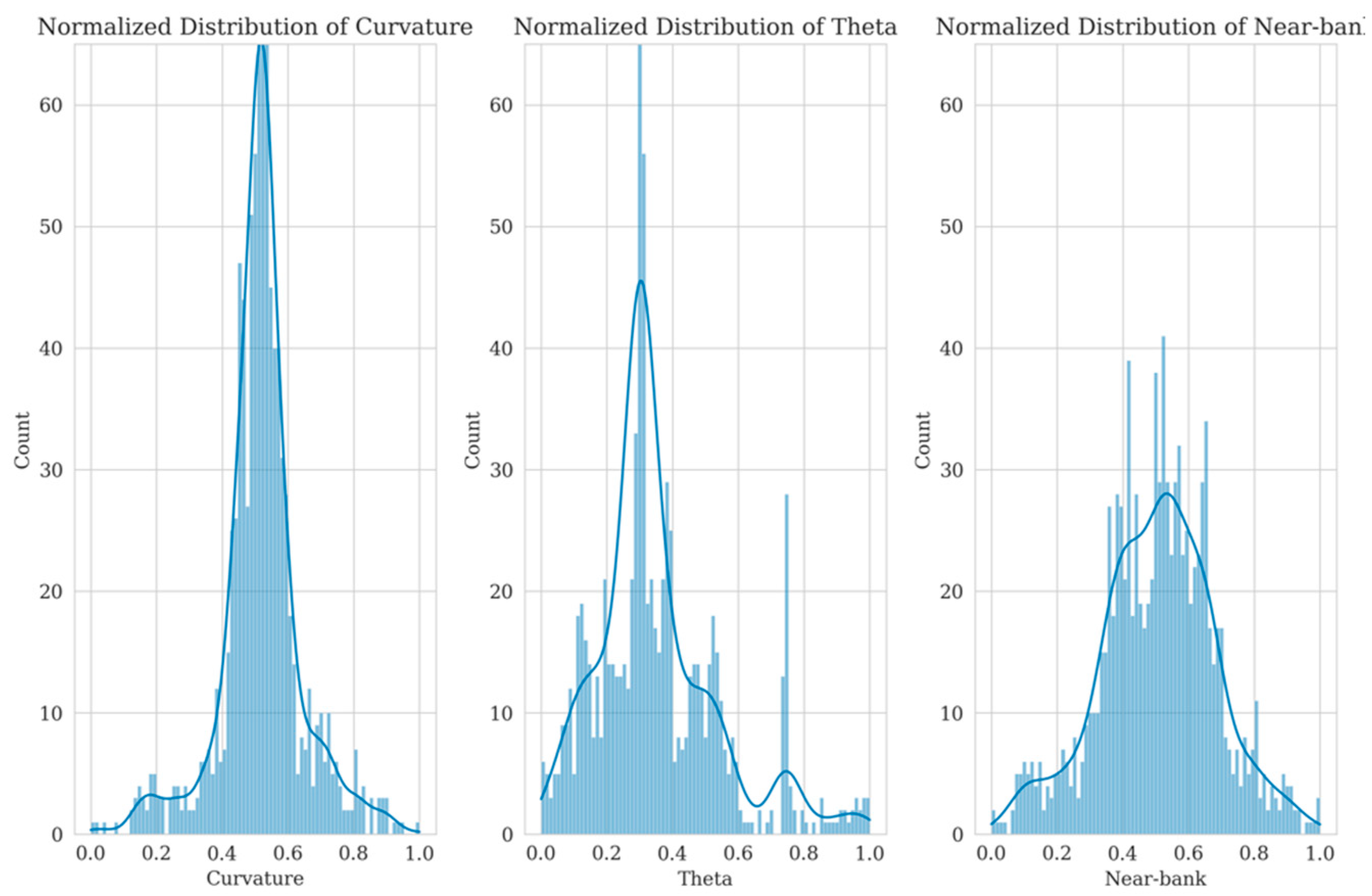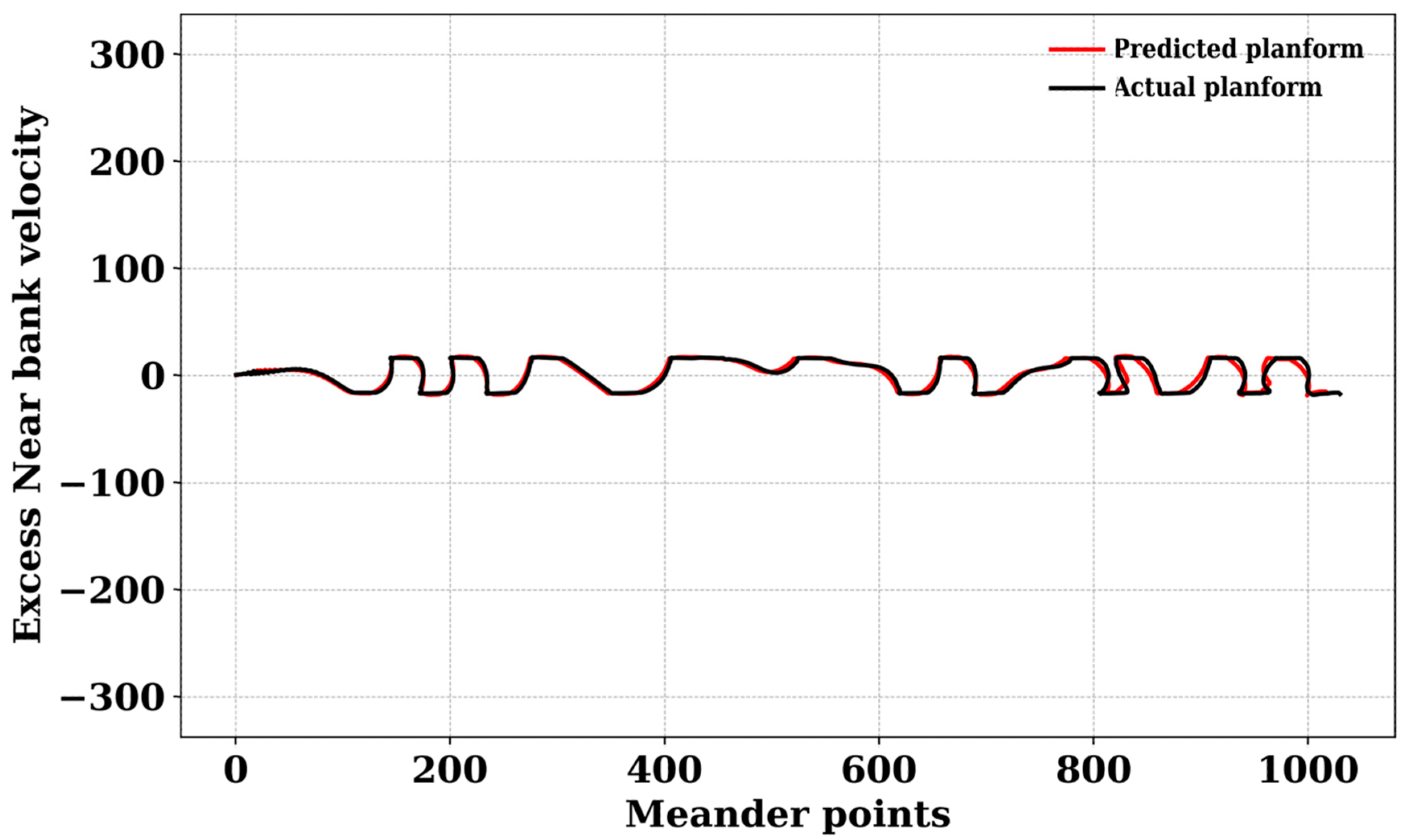Meanders on the Move: Can AI-Based Solutions Predict Where They Will Be Located?
Abstract
:1. Introduction
2. Material and Methods
2.1. Planform Evolution Processing
2.2. Artificial Intelligence (AI)
3. Results and Discussion
4. Conclusions
Author Contributions
Funding
Data Availability Statement
Acknowledgments
Conflicts of Interest
References
- Leopold, L.B.; Langbein, W.B. River Meanders. Sci. Am. 1966, 214, 60–70. [Google Scholar] [CrossRef]
- Seminara, G. Meanders. J. Fluid Mech. 2006, 554, 271–297. [Google Scholar] [CrossRef]
- Zolezzi, G.; Seminara, G. Downstream and upstream influence in river meandering. Part 1. General theory and application to overdeepening. J. Fluid Mech. 2001, 438, 183–211. [Google Scholar] [CrossRef]
- Motta, D.; Abad, J.D.; Langendoen, E.J.; García, M.H. The effects of floodplain soil heterogeneity on meander planform shape. Water Resour. Res. 2012, 48, 1–17. [Google Scholar] [CrossRef]
- Lanzoni, S.; Seminara, G. On the nature of meander instability. J. Geophys. Res. 2006, 111, F04006. [Google Scholar] [CrossRef]
- Schwendel, A.C.; Nicholas, A.P.; Aalto, R.E.; Sambrook Smith, G.H.; Buckley, S. Interaction between meander dynamics and floodplain heterogeneity in a large tropical sand-bed river: The Rio Beni, Bolivian Amazon. Earth Surf. Process. Landf. 2015, 40, 2026–2040. [Google Scholar] [CrossRef]
- Rozowski, I.L. Flow of Water in Bends of Open Channels; Academy of Sciences of the Ukrainian SSR: Kyiv, Ukraine, 1957. [Google Scholar]
- Thorne, C.R.; Hey, R.D. Direct measurements of secondary currents at a river inflexion point. Nature 1979, 280, 226–228. [Google Scholar] [CrossRef]
- Bolla Pittaluga, M.; Nobile, G.; Seminara, G. A nonlinear model for river meandering. Water Resour. Res. 2009, 45. [Google Scholar] [CrossRef]
- Duan, J.G.; Julien, P.Y. Numerical simulation of the inception of channel meandering. Earth Surf. Process. Landf. 2005, 30, 1093–1110. [Google Scholar] [CrossRef]
- Leopold, L.B.; Wolman, M.G. River Channel Patterns, Braided, Meandering and Straight; Schumm, S.A., Ed.; US Geological Survey: Reston, VA, USA, 1957; Volume 282-B.
- Sun, T.; Meakin, P.; Jøssang, T.; Schwarz, K. A simulation model for meandering rivers. Water Resour. Res. 1996, 32, 2937–2954. [Google Scholar] [CrossRef]
- Zolezzi, G.; Luchi, R.; Tubino, M. Morphodynamic regime of gravel bed, single-thread meandering rivers. J. Geophys. Res. 2009, 114, 1. [Google Scholar] [CrossRef]
- Johannesson, H.; Parker, G. Theory of River Meanders; University of Minnesota: Minneapolis, MN, USA, 1988; Available online: http://purl.umn.edu/114112 (accessed on 18 July 2024).
- Bogoni, M.; Putti, M.; Lanzoni, S. Modeling meander morphodynamics over self-formed heterogeneous floodplains. Water Resour. Res. 2017, 53, 5137–5157. [Google Scholar] [CrossRef]
- Ikeda, S.; Parker, G.; Sawai, K. Bend theory of river meanders. Part 1. Linear development. J. Fluid Mech. 1981, 112, 363–377. [Google Scholar] [CrossRef]
- Parker, G. On the cause and characteristic scales of meandering and braiding in rivers. J. Fluid Mech. 1976, 76, 457. [Google Scholar] [CrossRef]
- Bouaziz, M.; Medhioub, E.; Csaplovisc, E. A machine learning model for drought tracking and forecasting using remote precipitation data and a standardized precipitation index from arid regions. J. Arid Environ. 2021, 189, 104478. [Google Scholar] [CrossRef]
- Grbčić, L.; Družeta, S.; Mauša, G.; Lipić, T.; Lušić, D.V.; Alvir, M.; Lučin, I.; Sikirica, A.; Davidović, D.; Travaš, V.; et al. Coastal water quality prediction based on machine learning with feature interpretation and spatio-temporal analysis. Environ. Model. Softw. 2022, 155, 105458. [Google Scholar] [CrossRef]
- Tahmasebi, P.; Kamrava, S.; Bai, T.; Sahimi, M. Machine learning in geo- and environmental sciences: From small to large scale. Adv. Water Resour. 2020, 142, 103619. [Google Scholar] [CrossRef]
- Wang, Y.; Chen, J.; Cai, H.; Yu, Q.; Zhou, Z. Predicting water turbidity in a macro-tidal coastal bay using machine learning approaches. Estuar. Coast. Shelf Sci. 2021, 252, 107276. [Google Scholar] [CrossRef]
- Camporeale, C.; Perona, P.; Porporato, A.; Ridolfi, L. Hierarchy of models for meandering rivers and related morphodynamic processes. Rev. Geophys. 2007, 45. [Google Scholar] [CrossRef]
- Frascati, A.; Lanzoni, S. Morphodynamic regime and long-term evolution of meandering rivers. J. Geophys. Res. 2009, 114, 1–9. [Google Scholar] [CrossRef]
- Parsaie, A.; Haghiabi, A.H.; Moradinejad, A. Prediction of Scour Depth below River Pipeline using Support Vector Machine. KSCE J. Civ. Eng. 2019, 23, 2503–2513. [Google Scholar] [CrossRef]
- Seminara, G.; Tubino, M. Free–forced interactions in developing meanders and suppression of free bars. J. Fluid Mech. 1990, 214, 131–159. [Google Scholar]
- Van de Lageweg, W.I.; Van Dijk, W.M.; Hoendervoogt, R.; Kleinhans, M.G. Effects of riparian vegetation on experimental channel dynamics. Riverflow 2010, 2, 1331–1338. [Google Scholar]
- Monegaglia, F.; Zolezzi, G.; Gunerlap, I.; Henshaw, A.J.; Tubino, M. Automated extraction of meandering river morphodynamics from multitemporal remotely sensed data. Environ. Model. Softw. 2018, 105, 171–186. [Google Scholar] [CrossRef]
- Seminara, G.; Zolezzi, G.; Tubino, M.; Zardi, D. Downstream and upstream influence in river meandering. Part 2. Planimetric development. J. Fluid Mech. 2001, 438, 213–230. [Google Scholar] [CrossRef]
- Mohammed, H.; Longva, A.; Seidu, R. Predictive analysis of microbial water quality using machine-learning algorithms. Environ. Res. Eng. Manag. 2018, 74, 7–20. [Google Scholar] [CrossRef]
- Zhong, S.; Zhang, K.; Bagheri, M.; Burken, J.G.; Gu, A.; Li, B.; Ma, X.; Marrone, B.L.; Ren, Z.J.; Schrier, J.; et al. Machine Learning: New Ideas and Tools in Environmental Science and Engineering. Environ. Sci. Technol. 2021, 55, 12741–12754. [Google Scholar] [CrossRef]
- Schmidt, L.; Heße, F.; Attinger, S.; Kumar, R. Challenges in Applying Machine Learning Models for Hydrological Inference: A Case Study for Flooding Events Across Germany. Water Resour. Res. 2020, 56, e2019WR025924. [Google Scholar] [CrossRef]
- Lamba, A.; Cassey, P.; Segaran, R.R.; Koh, P.L. Deep learning for environmental conservation. Curr. Biol. 2019, 29, 977–982. [Google Scholar] [CrossRef]
- Goodwin, M.; Halvorsen, K.T.; Jiao, L.; Knausgård, K.M.; Martin, A.H.; Moyano, M.; Oomen, R.A.; Rasmussen, J.H.; Sørdalen, T.K.; Thorbjørnsen, S.H. Unlocking the potential of deep learning for marine ecology: Overview, applications, and outlook. ICES J. Mar. Sci. 2022, 79, 319–336. [Google Scholar] [CrossRef]
- Mitchell, T.M. Machine Learning and Data Mining. Commun. ACM 1999, 42, 30–36. [Google Scholar] [CrossRef]
- Malde, K.; Handegard, N.O.; Eikvil, L.; Salberg, A.B. Machine intelligence and the data-driven future of marine science. ICES J. Mar. Sci. 2020, 77, 1274–1285. [Google Scholar] [CrossRef]
- Rubbens, P.; Brodie, S.; Cordier, T.; Destro Barcellos, D.; Devos, P.; Fernandes-Salvador, J.A.; Fincham, J.I.; Gomes, A.; Handegard, N.O.; Howell, K.; et al. Machine learning in marine ecology: An overview of techniques and applications. ICES J. Mar. Sci. 2023, 80, 1829–1853. [Google Scholar] [CrossRef]
- Casanovas-Massana, A.; Gómez-Doñate, M.; Sánchez, D.; Belanche-Muñoz, L.A.; Muniesa, M.; Blanch, A.R. Predicting fecal sources in waters with diverse pollution loads using general and molecular host-specific indicators and applying machine learning methods. J. Environ. Manag. 2015, 151, 317–325. [Google Scholar] [CrossRef] [PubMed]
- Chianese, E.; Camastra, F.; Ciaramella, A.; Landi, T.C.; Staiano, A.; Riccio, A. Spatio-temporal learning in predicting ambient particulate matter concentration by multi-layer perceptron. Ecol. Inform. 2019, 49, 54–61. [Google Scholar] [CrossRef]
- Bentéjac, C.; Csörgő, A.; Martínez-Muñoz, G. A comparative analysis of gradient boosting algorithms. Artif. Intell. Rev. 2021, 54, 1937–1967. [Google Scholar] [CrossRef]
- Chen, T.; Guestrin, C. XGBoost: A Scalable Tree Boosting System. In Proceedings of the 22nd ACM Sigkdd International Conference on Knowledge Discovery and Data Mining, San Francisco, CA, USA, 13–17 August 2016. [Google Scholar] [CrossRef]
- Joshi, A.; Pradhan, B.; Chakraborty, S.; Behera, M.D. Winter wheat yield prediction in the conterminous United States using solar-induced chlorophyll fluorescence data and XGBoost and random forest algorithm. Ecol. Inform. 2023, 77, 102194. [Google Scholar] [CrossRef]
- Shakeri, R.; Amini, H.; Fakheri, F.; Ketabchi, H. Assessment of drought conditions and prediction by machine learning algorithms using Standardized Precipitation Index and Standardized Water-Level Index (case study: Yazd province, Iran). Environ. Sci. Pollut. Res. 2023, 30, 101744–101760. [Google Scholar] [CrossRef]
- Lyashevska, O.; Harma, C.; Minto, C.; Clarke, M.; Brophy, D. Long-term trends in herring growth primarily linked to temperature by gradient boosting regression trees. Ecol. Inform. 2020, 60, 101154. [Google Scholar] [CrossRef]
- Persson, C.; Bacher, P.; Shiga, T.; Madsen, H. Multi-site solar power forecasting using gradient boosted regression trees. Sol. Energy 2017, 150, 423–436. [Google Scholar] [CrossRef]
- Otchere, D.A.; Ganat, T.O.A.; Ojero, J.O.; Tackie-Otoo, B.N.; Taki, M.Y. Application of gradient boosting regression model for the evaluation of feature selection techniques in improving reservoir characterisation predictions. J. Pet. Sci. Eng. 2022, 208, 109244. [Google Scholar] [CrossRef]
- Bennett, N.D.; Croke, B.F.W.; Guariso, G.; Guillaume, J.H.A.; Hamilton, S.H.; Jakeman, A.J.; Marsili-Libelli, S.; Newham, L.T.H.; Norton, J.P.; Perrin, C.; et al. Characterising performance of environmental models. Environ. Model. Softw. 2013, 40, 1–20. [Google Scholar] [CrossRef]
- Everaert, G.; Bennetsen, E.; Goethals, P.L.M. An applicability index for reliable and applicable decision trees in water quality modelling. Ecol. Inform. 2016, 32, 1–6. [Google Scholar] [CrossRef]
- Oseibryson, K. Post-pruning in regression tree induction: An integrated approach. Expert Syst. Appl. 2008, 34, 1481–1490. [Google Scholar] [CrossRef]










| MLP | |||||
|---|---|---|---|---|---|
| Activation function | Alpha | Hidden layer size | Solver | ||
| Tanh | 0.0005 | 10 | lbfgs | ||
| XGBoost | |||||
| Learning rate | Max depth | Objective | Sub sample | Col sample | Min child weight |
| 0.2 | Uniform | Auto | 40 | 2 | Minkowsiki |
| Gradient Boosting Regressor (GBR) | |||||
| Min sample split | Min sample leaf | Max variable | Learning rate | Number of estimators | Sub sample |
| 6 | Uniform | Auto | 0.1 | 150 | Minkowski |
| Decision Tree | |||||
| Criterion | Max depth | Splitter | ccp_alpha | ||
| Friedman_mse | 5 | Best | 0.1 | ||
| Metric | eXtreme Gradient Boosting | MLP Regressor | Gradient Boosting Regressor | Decision Tree Regressor |
|---|---|---|---|---|
| MAE | 0.0264 | 0.2042 | 0.0424 | 0.0343 |
| MSE | 0.0023 | 0.0647 | 0.0054 | 0.0064 |
| RMSE | 0.0475 | 0.2545 | 0.0733 | 0.0802 |
| R2 | 0.9197 | 0.4171 | 0.9516 | 0.9021 |
Disclaimer/Publisher’s Note: The statements, opinions and data contained in all publications are solely those of the individual author(s) and contributor(s) and not of MDPI and/or the editor(s). MDPI and/or the editor(s) disclaim responsibility for any injury to people or property resulting from any ideas, methods, instructions or products referred to in the content. |
© 2024 by the authors. Licensee MDPI, Basel, Switzerland. This article is an open access article distributed under the terms and conditions of the Creative Commons Attribution (CC BY) license (https://creativecommons.org/licenses/by/4.0/).
Share and Cite
Amini, H.; Monegaglia, F.; Shakeri, R.; Tubino, M.; Zolezzi, G. Meanders on the Move: Can AI-Based Solutions Predict Where They Will Be Located? Water 2024, 16, 2460. https://doi.org/10.3390/w16172460
Amini H, Monegaglia F, Shakeri R, Tubino M, Zolezzi G. Meanders on the Move: Can AI-Based Solutions Predict Where They Will Be Located? Water. 2024; 16(17):2460. https://doi.org/10.3390/w16172460
Chicago/Turabian StyleAmini, Hossein, Federico Monegaglia, Reza Shakeri, Marco Tubino, and Guido Zolezzi. 2024. "Meanders on the Move: Can AI-Based Solutions Predict Where They Will Be Located?" Water 16, no. 17: 2460. https://doi.org/10.3390/w16172460





